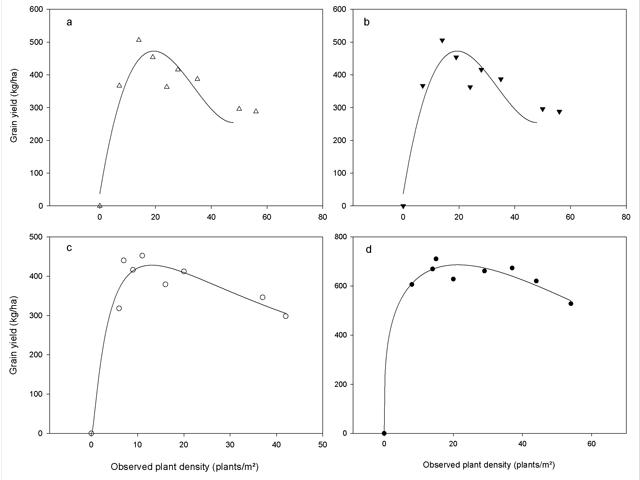Background
Breeding companies are favouring the development of hybrids in order to pay for breeding services.
Hybrids provide growers with more vigorous seedlings, comparatively better plant establishment and generally higher yields, however, growers have to purchase new seed of hybrid varieties every year in order to get these potential yield benefits.
Seed for hybrid canola is 10-25 times more expensive than the seed of open pollinated canola.
If growers are forced into hybrids they may wish to minimise seed costs by sowing at lower densities.
Aim
To investigate the plant density response to yield and oil content of TT and RR hybrid canola in comparison with open-pollinated canola.
Trial details
| Property | Mullewa Research Facility |
|---|---|
| Growing season rainfall (GSR) | 171mm 74% of long term mean (1975-2012), GSR + stored water (estimate) = 190mm, 71% of long term mean |
| Soil type | Loamy sand (organic carbon 0.35%) |
| Crop / variety | Canola |
| Paddock rotation | 2008 - wheat, 2009 - lupin, 2010 - wheat, 2011 - lupin (1t/ha), 2012 - wheat |
| Treatments | 36 treatments: 2 HT - Herbicide tolerant canola (TT and RR) 4 cultivar TT – OP = CB Telfer TT and Hybrid = Hyola 450TT RR - OP = GT Viper, Hybrid = Hyola 404 RR Eight densities of 5, 10, 15, 20, 30, 40, 60, or 80 plants/m2 |
| Replicates | Three |
| Sowing date | 9 May 2013 |
| Fertiliser (kg/ha) | At seeding: 70kg/ha of Agstar Extra 60 kg/ha of Urea, 14 May 2013: 400kg/ha of gypsum (17% Ca, 14% S) top-dressed over whole site. |
Assumptions used in costing
Oil bonus +/- 1.5% per unit of oil (%) either side of 42%, with no oil ceiling, non-treatment costs $147/ha.
RR costs – Hyola 404RR seed $31/kg, GT Viper $25/kg, herbicides $28/ha and grain worth $479/t (CBH Pool Geraldton, 5 November 2013).
TT costs – Hyola 450TT seed $24/kg and CB Telfer TT $2/kg which assumes farmers purchase new seed every three years at $11/kg and bulk up seed on 25% of their canola program.
Herbicides $47/ha and grain worth $499/t (CBH Pool Geraldton, 5 November 2013).
Results
In the dry conditions there was approximately 40% plant death, with high density treatments being more affected.
- Conditions at Mullewa in 2013 after seeding were tough and crops were struggling with only 3mm falling in June.
- Rainfall finally arrived in the second week of July but Mullewa still received less than 50% of average rainfall in July.
Dry matter at 100% flowering on 1 August indicated that low density treatments had fared the best in the dry conditions and produced 2-3t/ha compared to less than 2t/ha for densities above 40 plants/m2 (targets above 60).
Aphids were also problematic in the northern agricultural region and in particular at Mullewa, where they attacked stressed plants.
- Consequently high density plots appeared to be colonised to a greater extent than lower density plots.
- Conditions improved by August and above average rainfall in September and October helped the canola recover and produce biomass in the range of 1-5t/ha and grain yields in the range of 300-700kg/ha.
Hybrids performed surprisingly well at Mullewa in 2013.
- Hyola 404RR was the highest yielding RR variety at 637kg/ha and Hyola 450TT the highest yielding TT variety.
- We might have expected the earliest flowering variety CB Telfer TT to have performed better than Hyola 450TT but perhaps the extended spring helped Hyola 450TT more than CB Telfer TT.
- Similarly the hybrid varieties produced the highest oil percentage.
- However the grain yields of Hyola 450TT were not high enough to cover the high seed costs, such that CB Telfer TT despite being lower yielding and producing lower oil produced similar low gross margins as Hyola 450TT.
- The RR hybrid’s grain yield was sufficiently high to cover its seed costs and it produced higher gross margins than the RR OP variety GT Viper which performed particularly poorly.


Conclusion
All varieties responded similarly to plant density.
Grain yield peaked at a less than 20 plants/m2 and increases in plant density above 20 plants/m2 produced either similar yields and gross margins or reduced yield and gross margins.
Acknowledgements
This trial (13CH22) is one of a series conducted throughout WA as part of the GRDC and DPIRD co-funded project; Tactical break crop agronomy.
Thanks to the DPIRD Geraldton Research Facility for trial management and Jo Walker (DPIRD Geraldton) for kindly providing technical assistance to ensure all treatments and measurements occurred in a timely and accurate fashion.

